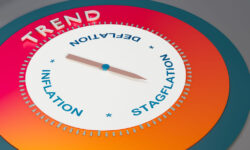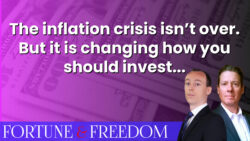What is the current rate of inflation?
In June, the annual rate of inflation hit a 40-year high. The consumer price index rose 9.4% year-on-year and the retail price index by 11.8%. Crucially, these figures were higher than in May, which means that inflation is still rising.
Core inflation, which strips out especially volatile parts of the inflation indices in order to focus on prices that tend to be more stable, rose 5.8%, which was less than the previous month.
The difference was largely driven by the price of petrol, which surged 20p.
This leaves the UK’s inflation slightly above the United States’ inflation rate of 9.1%, and above much of Europe’s, but still well below inflation in Spain and the Netherlands, where the numbers are in double-digits.
The Bank of England continues to forecast the inflation rate to rise to 11% this year as price spikes in commodities, energy and industrial goods make their way through the economy to the consumer.
How bad is inflation in 2022 compared to previous years?
The way we measure inflation has gradually changed over time, making long-term comparisons difficult. But, if you assume away this challenge, the last time we saw inflation as high as it is today was the early 1980s, or about 40 years ago.
In the 1970s, inflation roared out of control for almost a decade before it was brought under control in the 1980s. It also fluctuated up and down a lot during that time, which should be a warning for us today that the inflation genie is hard to get back in the bottle.
The importance of today’s inflation is how much higher it is than we’ve become used to since the 1970s. During that decade, inflation spent a great deal of time above 10%. But since the 1990s, it rarely rose above 5% and spent a great deal of time below 2%.
This means an entire generation has grown up without experiencing or understanding inflation the way previous generations did. Including those who manage our investments, economy and monetary system.
What caused inflation to get out of control?
It depends who you ask. The source of inflation is a hotly debated topic amongst economists. And the general public, now that we have an overdose of it in 2022.
Lockdown and the war in Ukraine
One theory is that we are experiencing what’s called a supply shock. Covid, the lockdowns and the war in Ukraine have created a perfect storm when it comes to producing and transporting basic goods.
Lumber
The first example was lumber, which saw an epic price spike in 2021. But, since then, all manner of goods, from used cars to potatoes, have been in short supply. And, simple supply and demand economics tells you that less supply means higher prices.
Central banks
Another theory is that central banks created too much money. Again, basic supply and demand economics tells you that more of something means it is worth less. And that applies to money too. A lower value of money is inflation.
Government spending
The third popular theory worth noting is that government spending caused the inflation. Vast stimulus programmes were imposed on economies to fight off the economic effects of Covid. Unfortunately, this money coincided with factories and businesses that had been shuttered because of lockdowns.
Can we stop inflation?
The true cause of inflation is incredibly important to determine because bringing inflation back under control means solving the underlying problem.
If we’re facing a supply shock, the goods production and trade must be prioritised.
If we’re facing monetary inflation, central banks must stop creating money and raise interest rates.
If government spending is the problem, the governments should cut back.
But a misdiagnosis could actually make things worse.
If central banks tighten monetary policy during a supply shock, for example, that’ll make it even harder to bring production of goods back online.
Or, if they don’t tighten monetary policy fast enough to offset inflation caused by loose monetary policy, it could spiral out of control.
Some governments have actually increased spending programmes to fight off inflation…
How bad will inflation get?
Just as our surprisingly high level of inflation was difficult to forecast, what happens next is difficult to predict too.
Producer Price Indices, which measure “factory gate prices” that producing companies pay for their raw materials, are still soaring in much of the world. This suggests that consumer prices still have some way to rise.
However, we are already seeing signs that the economy is responding to higher prices by slowing down. An economic slowdown reduces the effects of monetary and supply shock inflation.
There is a chance that inflation expectations will become a self-fulfilling prophecy. If people expect high inflation, they raise prices and cause the very inflation they expect. This is especially true when it comes to wages. Economists call this a wage-price spiral, where inflation and wages rise together, reinforcing each other.
How to profit from inflation
Inflation rewrites the rule book of investing. At least, the books that were written over the past 40 years…
But if you go back further, you’ll discover that inflation is not an unusual problem for investors to face. And there are plenty of solutions.
Low-risk options
The first is to shift the low-risk portion of your investments from bonds into gold. For decades now, bonds have been described as a low-risk investment which people should hold to reduce the overall risk in their portfolio. But inflation reverses this because it devalues the money that bonds pay you. They have gone from risk-free returns to return-free risk.
Gold, on the other hand, has preserved wealth for thousands of years. Many currencies have come and gone while gold remains the same. And it has held its purchasing power very well over that time too.
Companies with pricing power
Shifting your stock market investments to companies that have pricing power is another adjustment you can make to protect yourself from inflation. This means investing in companies that have a unique product which they can easily raise prices for, such as Microsoft, or a company that simply passes on inflation to consumers, such as grocery chains.
The companies that struggle during inflation are the ones without pricing power. They have many substitute goods or services which people can buy instead, such as luxury goods and travel.
Assets with debt
A third option is to invest in assets that use a lot of debt, such as property. Inflation makes debt easier to pay off because the money it is denominated in devalues over time. But this option may be risky as interest rates rise.
How can investors keep on step ahead of the threats from inflation?
We’re facing one of the worst crises in decades and I don’t want you to face it alone.
Over the next few weeks I’ll be sharing more tips you could use to help protect your wealth.
And you can get them delivered straight into your inbox when you subscribe to my FREE daily newsletter “Fortune & Freedom”.
Together with three of the UK’s top investing experts we’ll be uncovering the truth behind the headlines and telling you what it could mean for your money.
To claim your free subscription, simply type your email address below.

Nick Hubble
Editor, Fortune & Freedom




